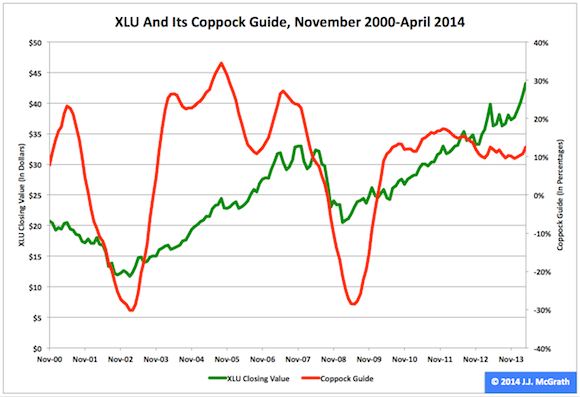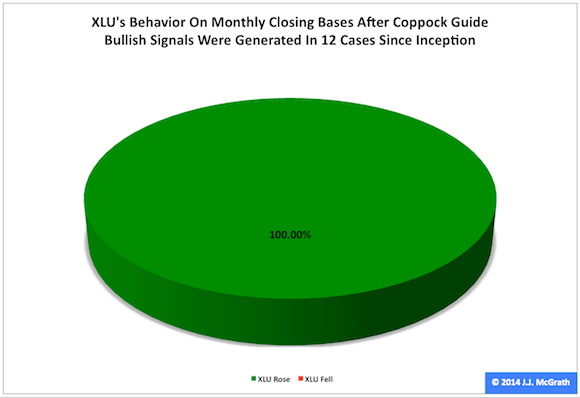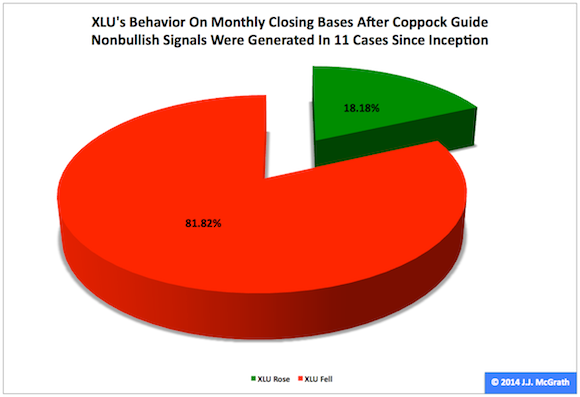Mr. Market’s psychological transition from manic last year
to depressive this year has been mirrored by the behaviors of the Select
Sector SPDRs dividing the S&P 500 into nine pieces, as reported in “Utilities No. 1 Among Select Sector SPDR ETFs In
2014 As Of Mid-April” at Seeking Alpha.
The Utilities SPDR exchange-traded fund (XLU) was the best performer among
its peers during the first third of 2014, as its adjusted closing share price advanced
to $43.21 from $37.66, a gain of $5.55, or 14.74 percent. By way of comparison,
the SPDR S&P 500 ETF (SPY)
climbed to $188.31 from $183.88, an increase of $4.43, or 2.41 percent.
Accordingly, I am happy to have XLU as the first of a
baker’s dozen ETFs to be featured this month in a J.J.’s Risky
Business blog series being launched today. Basically, I will be looking
at each ETF with both eyes fixed on its Coppock guide, as was the case in “SPY Coppock Guide: Away From Bullishness, Toward
Nonbullishness as of March 31, 2014.”
The Coppock guide, aka either the Coppock curve or the Coppock
indicator, is a long-term indicator of price movements in major stock-market
indexes introduced by Edwin S. Coppock in Barron’s
more than half a century ago. Both the indicator’s history and its methodology
are interesting in themselves, but my focus now is on its relevance to XLU.
Figure 1: XLU And Its
Coppock Guide, The Complete History
Note: The XLU
closing-value scale is on the left, and the Coppock guide scale is on the
right.
Source: This J.J.’s
Risky Business chart is based on
proprietary analyses of Yahoo Finance adjusted monthly share-price data and those data themselves.
Coppock developed his long-term guide not to generate both
bullish and bearish signals but to generate only bullish signals. However, I
employ it to generate either bullish or nonbullish signals. It is extremely
important to keep in mind that in the context of the Coppock guide a nonbullish
signal is not equivalent to a bearish
signal. In my use of the indicator, I anticipate XLU may advance after a bullish
signal and expect it might do anything following a nonbullish signal
(i.e., trade higher, lower or sideways).
Figure 2: XLU’s
Behavior Subsequent To Initial Bullish Signals
Source: This J.J.’s
Risky Business chart is based on
proprietary analyses of Yahoo Finance adjusted monthly share-price data.
The XLU Coppock guide’s initial bullish signals collectively
have compiled a perfect record in prognosticating the future upward movements
of the ETF on monthly closing bases, as they have been accurate in all 12 cases
since November 2000. The most recent bullish signal was generated last
December, when XLU’s closing share price was $37.66.
Because of a one-month lag in the confirmation of a Coppock
guide signal, however, I used XLU’s closing share price of $38.78 in January as
the baseline in determining the success or failure of the latest signal. As
mentioned above, the ETF’s final print was $43.21 in April.
Figure 3: XLU’s
Behavior Subsequent To Initial Nonbullish Signals
Source: This J.J.’s
Risky Business chart is based on
proprietary analyses of Yahoo Finance adjusted monthly share-price data.
The XLU Coppock guide’s initial nonbullish signals
collectively have compiled a pretty interesting track record of their own. Keeping
in mind that in the context of the Coppock guide a nonbullish signal is not equivalent to a bearish signal, XLU since
November 2000 has fallen on nine occasions, or 81.82 percent of the time, and
risen on two occasions, or 18.18 percent of the time, in the wake of nonbullish
signals.
I monitor XLU because I believe it is key to any analysis of
market sentiment based on the comparative behaviors of the nine Select Sector SPDRs. If XLU
ranks either at or close to No. 1 in relative returns during a given period,
then I think market participants are generally in risk-off mode; if XLU ranks
either at or close to No. 9 in relative returns over a given period, then I
think market participants are generally in risk-on mode.
Author’s Note: This first
blog post in a series centered on the Coppock guides of 13 important ETFs is
being cross-posted at both J.J.’s Risky
Business and J.J. McGrath’s Instablog on
Seeking Alpha. The rest of the series will be posted at the former location.
You can follow me (and the series) @JJMcGrath3000 on Twitter, at JJMcGrath on StockTwits and via myself on Google+.
Disclaimer: The opinions expressed
herein by the author do not constitute an investment recommendation, and they
are unsuitable for employment in the making of investment decisions. The
opinions expressed herein address only certain aspects of potential investment
in any securities and cannot substitute for comprehensive investment analysis.
The opinions expressed herein are based on an incomplete set of information,
illustrative in nature, and limited in scope. In addition, the opinions
expressed herein reflect the author’s best judgment as of the date of
publication, and they are subject to change without notice.



No comments:
Post a Comment